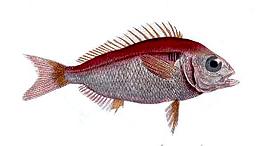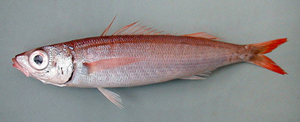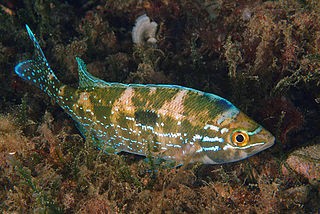
Pagellus is a genus of marine ray-finned fish belonging the family Sparidae, which includes the seabreams and porgies. These fishes are found in the eastern Atlantic Ocean, the Mediterranean Sea and the western Indian Ocean.

Lithognathus is a genus of marine ray-finned fish belonging to the family Sparidae, which includes the seabreams and porgies. Species in this genus are given the common name of steenbras. The genus is found in the Eastern Atlantic Ocean from southwestern Europe to South Africa and into the southwestern Indian Ocean.

The saddled seabream, also called the saddle bream or oblade, is a species of ray-finned fish belonging to the family Sparidae, which includes the seabreams and porgies. It is the only species in the monospecific genus Oblada. This species is found in the Eastern Atlantic Ocean. It is an important food fish within its range.

Diplodus is a genus of marine ray-finned fish belonging the family Sparidae, which includes the seabreams and porgies. These fishes are found in the Atlantic Ocean, the Mediterranean Sea and the western Indian Ocean.

Centracanthus cirrus, the curled picarel, is a species of marine ray-finned fish belonging to the family Sparidae, the seabreams and porgies. This fish is found in the temperate Eastern Atlantic Ocean and the Mediterranean and Black Seas. It is the only extant species in the genus Centracanthus. This species is of minor importance to commercial fisheries.

Centracanthus is a genus of marine ray-finned fishes belonging to the family Sparidae, the seabreams and porgies. There is a single extant species in this genus, as well as an extinct species classified within the genus. The extant species is found in the eastern Atlantic Ocean, the Mediterranean Sea and Black Sea.

Spicara is a genus of ray-finned fish belonging to the family Sparidae, which includes the seabreams and porgies. These fishes are found in the Atlantic and Indian Oceans. The species in the genus are known as picarels.

Mendosoma is a genus of marine ray finned fish belonging to the family Latridae, the trumpeters.

Spicara maena, the blotched picarel, is a species of ray-finned fish native to the eastern Atlantic Ocean, the Mediterranean Sea and the Black Sea. The male grows to a maximum length of about 25 cm (10 in), and the female reaches 21 cm (8 in). This fish is fished commercially in some areas.

Spicara smaris, one of the picarels, is a species of ray-finned fish belonging to the family Sparidae, the seabreams and porgies. This species is found in the eastern Atlantic Ocean, the Mediterranean Sea and the Black Sea. It grows to a maximum length of about 20 cm (8 in); females are usually smaller than males.

Rhabdosargus is a genus of ray-finned fish belonging to the family Sparidae, which includes the seabreams and porgies. These fishes are found in the southeastern Atlantic Ocean and throughout the Indo-West Pacific, although mainly in the western Indian Ocean.

Dentex is a genus of marine ray-finned fishes belonging to the family Sparidae, which includes the seabreams and porgies. The fishes in this genus are found in the eastern Atlantic Ocean and the eastern Indian and Western Pacific Oceans.

Sparodon, commonly known as the white musselcracker, musselcracker seabream, mussel cracker seabream, brusher, or cracker. is a monotypic genus of fish in the family Sparidae. The type and only known species, Sparodon durbanensis, was first described and named by François Louis Nompar de Caumont de Laporte, comte de Castelnau, in 1861.

Diplodus annularis, the annular seabream is a species of marine ray-finned fish belonging to the family Sparidae, the family which includes the seabreams and porgies. This species is found in the Eastern Atlantic Ocean and Mediterranean.

Spondyliosoma is a genus of marine ray-finned fish belonging to the family Sparidae, which includes the seabreams and porgies. The genus contains two species, one, the black seabream, from the eastern Atlantic Ocean and the other, the steentjie seabream, from the western Indian Ocean.

Spicara axillare, the windtoy, is a species of marine ray-finned fish belonging to the family Sparidae, the seabreams and porgies. This species is found in the Western Indian Ocean and is endemic to South Africa.

Evynnis is a genus of marine ray-finned fishes belonging to the family Sparidae, which includes the seabreams and porgies. The genus comprises 4 species, 3 in the Western Pacific Ocean and 1 in the Eastern Atlantic Ocean.

Pachymetopon is a genus of marine ray-finned fishes belonging to the family Sparidae, which includes the seabreams and porgies. The species in this genus are endemic to Southern Africa.

Polyamblyodon is a genus of marin ray-finned fishes belonging to the family Sparidae, which includes the seabreams and porgies. The fishes in this genus are found in the Western Indian Ocean.

Stenotomus is a genus of marine ray-finned fish belonging to the family Sparidae, which includes the seabreams and porgies. The fishes in this genus are found in the western Atlantic Ocean.



















